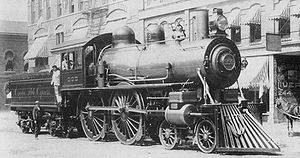New York Central and Hudson River Railroad No. 999

Engine 999 in Syracuse.
|
|||||||||||||||||||
|
|||||||||||||||||||
|
|||||||||||||||||||
|
|||||||||||||||||||
| Type and origin | |
|---|---|
| Power type | Steam |
| Builder | NYC West Albany Shops |
| Build date | 1893 |
| Specifications | |
|---|---|
| Configuration | 4-4-0 |
| Gauge | 4 ft 8 1⁄2 in (1,435 mm) |
| Driver dia. | 86.5 in (2,197 mm) |
| Adhesive weight | 84,000 lb (38.1 tonnes) |
| Loco weight | 124,000 lb (56.2 tonnes) |
| Boiler pressure | 180 lbf/in2 (1,241 kPa) |
| Cylinders | Two, outside |
| Cylinder size | 15 in (381 mm) |
| Career | |
|---|---|
| Operators | New York Central and Hudson River Railroad |
| Numbers | 999, renum 1086 in 1913, 1021 in 1920 |
| First run | May 1893 |
| Retired | 1952 |
| Current owner | Chicago Museum of Science and Industry |
| Disposition | static display |
New York Central and Hudson River Railroad No. 999 is a 4-4-0 steam locomotive built for the New York Central and Hudson River Railroad in 1893, which was intended to haul the road's Empire State Express train service. It is claimed that in 1893 No. 999 was the first in the world to travel over 100 mph, although the probable maximum speed was 81 mph.
In the early 1890s, the competition between the New York Central and Pennsylvania Railroads was growing fiercely. Their rivalry was particularly noticeable along their Chicago to New York corridors in the years leading to the Chicago World's Fair, with both roads trying to provide the most swift service to the fair. The Pennsylvania had upgraded its Pennsylvania Limited with the most modern and efficient rolling stock of the time. The New York Central similarly upgraded its Empire State Express train's rolling stock, however, knowing that this would not be enough, the road began exploring other options so as to outperform its rival. To this end came George Henry Daniels, the road's chief public representative officer. He proposed a new locomotive design capable of exceeding the "magical" 100-mph speed barrier. This was a daring undertaking, as the engines at the time typically traveled at one-half of that speed, and there was very little experience in making such fast engines.
Fortunately, the New York Central's Chief Superintendent of Motive Power & Rolling Stock, William Buchanan, had designed a class of 4-4-0 locomotives known as the Class "I", which were already capable of reaching speeds close to 100 mph, so it was simply a matter of making some modifications to an existing design.
The 999 was mounted on 86-inch (220 cm) diameter driving wheels rather than the 70-inch (180 cm) driving wheels mounted on other engines of the class, and was the first of its kind to have brakes mounted to the front truck. The bands, pipes, and trim were highly polished; the boiler, smokestack, domes, cab, and tender were given a black satin finish, and "Empire State Express" was applied to the sides of the tender in 2 ft 6 in (762 mm) high gold leaf lettering.
No. 999 entered service in 1893, making the trip from Syracuse, New York. The Express was recorded traveling at 102.8 miles per hour (165.4 km/h) on May 9 and at 112.5 miles per hour (181.1 km/h) on May 10, between Batavia and Buffalo. If true it would have made No. 999 the first object on wheels to exceed 100 mph, but no documentation (i.e. passing times at a sequence of identified points) has been given. The railway enthusiast and experienced timer of trains J P Pearson travelled behind 999 on May 10, he later described the trip in detail in his book "Railways & Scenery". The highest speed he recorded between New York and Buffalo was 81 mph sustained for several miles whilst descending from Batavia to Buffalo, a high speed for a regular passenger train of that era, though one that had been exceeded by other locomotives in special trials. Although 999 was fitted with a speed recorder the 100 mile an hour claims were based on milepost timings by newspaper reporters. The highest speed seen on the speed recorder appears to be 86 miles an hour in April 1893.
...
Wikipedia
